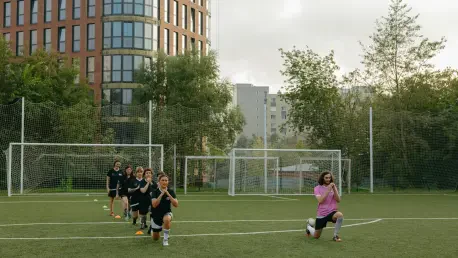The integration of cognitive activation strategies within physical education has emerged as a transformative approach, sparking interest across educational circles globally. These strategies challenge traditional teaching methods by emphasizing active learning and higher-order thinking rather than rote memorization. Educational institutions in Southwest China have become focal points for research, given the region’s socioeconomic disparities affecting access to educational resources. Exploring how cognitive activation can enhance student engagement, physical performance, and health behaviors is crucial for developing inclusive educational systems that prioritize both cognitive and physical development. Insights gained from such research could redefine teaching methods and improve educational outcomes, particularly in primary schools where foundational learning takes place.
Theoretical Foundations of Cognitive Activation
Cognitive activation teaching strategies are rooted in engaging students in processes that cultivate deep understanding and active participation. This approach challenges the traditional reliance on memorization, encouraging students to think critically through open-ended questions and problem-solving tasks. Such techniques aim to develop students’ ability to articulate reasoning and comprehend complex subjects, fostering an environment conducive to intellectual growth. While empirical evidence supports the effectiveness of cognitive activation strategies in enhancing engagement and performance in various disciplines, their application within the physical education sector remains insufficiently explored. Understanding their theoretical underpinnings helps educators implement these strategies effectively, providing students with opportunities to develop critical thinking skills that echo into their physical education experiences.
The essence of cognitive activation lies in its ability to make learning more interactive and meaningful, shifting the focus from passive absorption of knowledge to active participation. Educational psychology suggests that engaging students cognitively prompts a stronger grasp of concepts, which can translate into better academic outcomes. In physical education, this could mean structuring lessons to include decision-making tasks, reflective discussions, and collaborative exercises, all supported by varied instructional techniques. These methods have the potential to sustain students’ interest, drive motivation, and enrich the learning process beyond the confines of traditional educational models. By leveraging cognitive activation strategies, educators can foster a classroom environment that supports holistic education, emphasizing both intellectual and physical development.
Objectives and Hypotheses of the Study
Analyzing the impact of cognitive activation strategies on physical education involves multifaceted objectives aimed at understanding how these strategies improve student outcomes. The primary goal is to evaluate enhancements in classroom engagement, physical performance, and health behaviors resulting from cognitive activation. Concurrently, understanding the mechanisms that support these improvements provides deeper insights into how cognitive activation affects students at individual and classroom levels. Furthermore, assessing these mechanisms at the learning level allows educators to tailor strategies aligning with students’ diverse needs, ensuring all aspects of development are addressed adequately.
By reviewing existing literature, several hypotheses underline the potential of cognitive activation strategies to revolutionize physical education:
- Positive effects on health behaviors are anticipated as students actively reflect on choices, developing healthier lifestyle habits.
- Anticipated improvements in physical performance result from increased engagement and motivation, driven by cognitive activation methods.
- Classroom engagement serves as a mediator in achieving desired educational outcomes, linking cognitive methods with measurable improvements in health behaviors and physical performance.
This comprehensive approach underscores the necessity for educational research, providing empirical backing for implementing cognitive activation in physical education environments.
Methodology for Assessing Cognitive Activation
The methodological framework designed to evaluate cognitive activation strategies in physical education employs both quantitative and qualitative approaches. This dual-method approach ensures a robust analysis, capturing the complexity of cognitive activation’s impact on student outcomes. Data collection involves a stratified three-stage sampling design, carefully choosing participants from urban and rural settings to obtain a representative sample. Surveys are distributed to students and parents alike, while interviews and classroom observations provide supplementary qualitative data, painting a complete picture of the educational landscape.
This quantitative analysis focuses on statistical measurements, assessing variables such as classroom engagement, self-efficacy, and motivation levels, among others. Meanwhile, qualitative insights from observation and interviews provide depth, offering context to quantitative findings and fueling a comprehensive understanding of cognitive strategies in practice. The intricate connection between quantitative metrics and qualitative experiences illuminates how cognitive activation stimulates educational achievements, paving the way for refining teaching strategies that better address student needs. By integrating diverse data sources, this methodological approach captures the multifaceted dynamics of cognitive activation, helping educators leverage these strategies to bolster physical education.
Key Findings and Implications
Implementing cognitive activation strategies dramatically impacted classroom engagement, self-efficacy, and motivation, showcasing potential improvements in educational outcomes. Students exposed to these strategies are more likely to internalize healthy habits, reflecting an overarching enhancement in physical fitness. Furthermore, engagement proved instrumental, driving motivation and the desire to actively participate in physical education activities. As engagement mediates outcomes, its role highlights the significance of crafting structured and supportive teaching methods that inherently propel student success.
Interconnected to enhanced engagement is the noticeable rise in self-efficacy, evidencing students’ growing confidence to undertake physical challenges. This increase in self-assurance aligns closely with improved physical performance and health behaviors, underscoring the relationship between confidence and achievement. However, contrary to initial expectations, emotional regulation did not demonstrate significant mediation effects, suggesting other factors may better address emotional dynamics within sports learning. Motivation also holds a unique position, effectively bridging cognitive activation with physical performance gains yet exerting limited influence on health behaviors. These nuanced insights carry profound implications for physical education, driving the development of strategies targeting comprehensive student development.
Future Directions for Educational Research
Cognitive activation teaching strategies focus on engaging students in learning processes that promote deep understanding and active involvement. Rather than relying on memorization, this approach encourages critical thinking by using open-ended questions and tasks that require problem-solving. These techniques aim to improve students’ ability to explain their reasoning and understand complex subjects, creating an environment that supports intellectual growth. Although much evidence shows that cognitive activation can boost engagement and performance in various subjects, its use in physical education hasn’t been thoroughly studied. Understanding the theory behind these strategies helps teachers implement them effectively, offering students chances to develop critical thinking skills that extend into their physical education experiences.
The core of cognitive activation is making learning more interactive and substantial, moving away from passively absorbing knowledge to actively participating. Educational psychology indicates that when students are engaged in this way, they gain a stronger understanding of concepts, which can lead to better academic performance. In physical education, this might involve organizing lessons around decision-making tasks, reflective discussions, and group exercises, using diverse teaching methods. These strategies have the potential to maintain student interest, boost motivation, and enrich the learning process beyond traditional models. By employing cognitive activation strategies, educators can create a classroom atmosphere that encourages both intellectual and physical development, promoting a well-rounded education.









